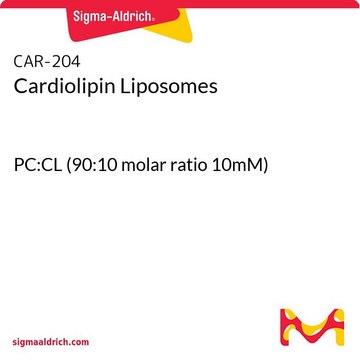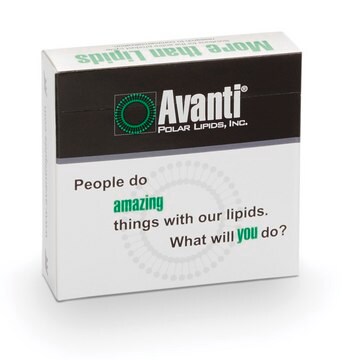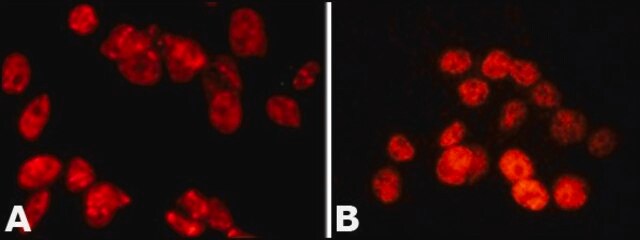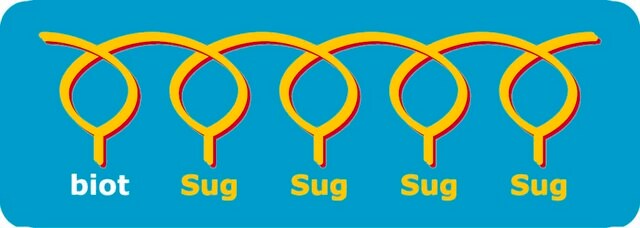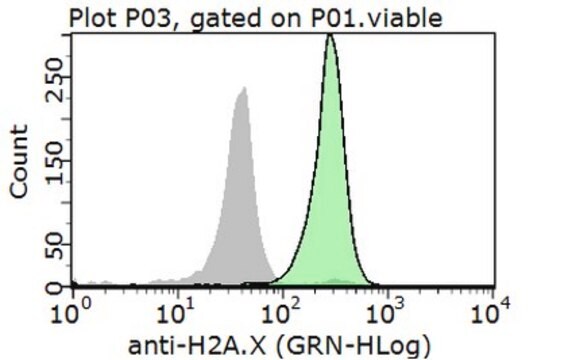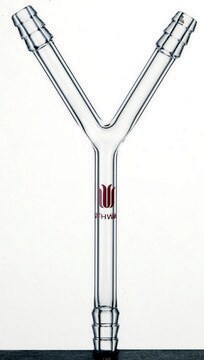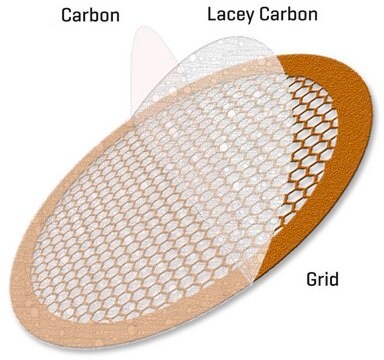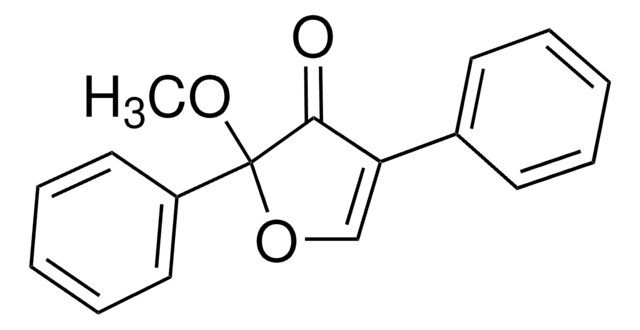CAR-203
Cardiolipin Liposomes
100% 14:0 Cardiolipin (TMCL) (10mM)
Autenticatiper visualizzare i prezzi riservati alla tua organizzazione & contrattuali
About This Item
Codice UNSPSC:
12352211
NACRES:
NA.25
Prodotti consigliati
Livello qualitativo
Composizione
Phosphate buffered saline
Concentrazione
10 mM
Impurezze
100% 14:1 Cardiolipin (TMCL)
Dimensione particelle
100 nm
pH
7.4
Cerchi prodotti simili? Visita Guida al confronto tra prodotti
Descrizione generale
Liposomes are extensively used to study the interaction of proteins, peptides and other molecules with the surface of a lipid membrane.
Cardiolipin (CL) is a unique phospholipid with an interesting chemical and ultrastructural characteristics. It is a highly acidic dimer of phosphatidylglycerol (PG) and phosphatidic acid (PA) containing four acyl chains, three glycerols and two phosphate headgroups. Due to deprotonation of one of these phosphate groups, cardiolipin is negatively charged in physiological pH.
Cardiolipin (CL) is known as a mitochondria-specific phospholipid and is intimately linked to mitochondrial bioenergetic processes. It plays a functional role in mitochondrial membrane stability and dynamics, as it interacts with a number of inner mitochondrial membrane metabolite carriers, enzymes and proteins. Extensive studies of phamacological, toxicological, and therapeutic effects have shown that the incorporation of doxorubicin in cardiolipin liposomes improved antitumor activity. It has been reported that cardiolipin-containing liposomes have lower cardiotoxicity associated with doxorubicin by alteriing the pharmacokinetics and tissue distribution of the drug.
Cardiolipin is a negatively charged lipid and provides two types of binding possibilities: binding at the surface and encapsulation deep within the membrane. Our catalog of cardiolipin lipids contains many different types of saturated and unsaturated cardiolipin based liposomes made from 0.5% up to 100% cardiolipin.
Cardiolipin (CL) is a unique phospholipid with an interesting chemical and ultrastructural characteristics. It is a highly acidic dimer of phosphatidylglycerol (PG) and phosphatidic acid (PA) containing four acyl chains, three glycerols and two phosphate headgroups. Due to deprotonation of one of these phosphate groups, cardiolipin is negatively charged in physiological pH.
Cardiolipin (CL) is known as a mitochondria-specific phospholipid and is intimately linked to mitochondrial bioenergetic processes. It plays a functional role in mitochondrial membrane stability and dynamics, as it interacts with a number of inner mitochondrial membrane metabolite carriers, enzymes and proteins. Extensive studies of phamacological, toxicological, and therapeutic effects have shown that the incorporation of doxorubicin in cardiolipin liposomes improved antitumor activity. It has been reported that cardiolipin-containing liposomes have lower cardiotoxicity associated with doxorubicin by alteriing the pharmacokinetics and tissue distribution of the drug.
Cardiolipin is a negatively charged lipid and provides two types of binding possibilities: binding at the surface and encapsulation deep within the membrane. Our catalog of cardiolipin lipids contains many different types of saturated and unsaturated cardiolipin based liposomes made from 0.5% up to 100% cardiolipin.
Applicazioni
Drug delivery
Lipid-protein interactions
Lipid-protein interactions
Stoccaggio e stabilità
Liposomes should never be frozen. Liposomes should be stored in the dark at 4°C, except when brought to room temperature for brief periods prior to use.
Liposomes are made under sterile conditions. If you need to take multiple aliquots out of the vial, it is advised to take extreme care in not contaminating the vial. It is recommended to handle the vial under a sterile hood to maintain the sterility of the product. Liposomes should never be frozen. Ice crystals that form during freezing will rupture the lipid membrane of the liposomes and change the size of liposomes particles.
Liposomes are made under sterile conditions. If you need to take multiple aliquots out of the vial, it is advised to take extreme care in not contaminating the vial. It is recommended to handle the vial under a sterile hood to maintain the sterility of the product. Liposomes should never be frozen. Ice crystals that form during freezing will rupture the lipid membrane of the liposomes and change the size of liposomes particles.
Note legali
Cellsome is a trademark of Encapsula NanoSciences
Product of Encapsula Nanosciences
Esclusione di responsabilità
For research use only
Codice della classe di stoccaggio
12 - Non Combustible Liquids
Classe di pericolosità dell'acqua (WGK)
WGK 2
Punto d’infiammabilità (°F)
Not applicable
Punto d’infiammabilità (°C)
Not applicable
Scegli una delle versioni più recenti:
Certificati d'analisi (COA)
Lot/Batch Number
Ci dispiace, ma al momento non ci sono COA disponibili online per questo prodotto.
Se ti serve aiuto, non esitare a contattarci Servizio Clienti
Possiedi già questo prodotto?
I documenti relativi ai prodotti acquistati recentemente sono disponibili nell’Archivio dei documenti.
Il team dei nostri ricercatori vanta grande esperienza in tutte le aree della ricerca quali Life Science, scienza dei materiali, sintesi chimica, cromatografia, discipline analitiche, ecc..
Contatta l'Assistenza Tecnica.